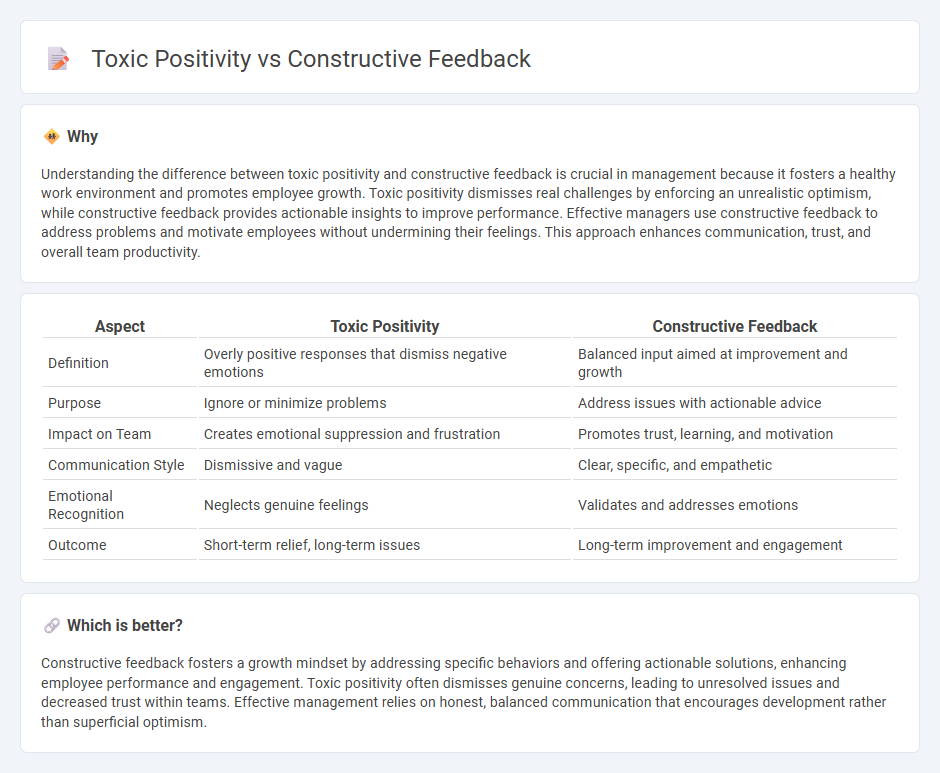
Toxic positivity undermines genuine communication by dismissing negative emotions and encouraging a facade of constant happiness, which can stifle growth and problem-solving within teams. Constructive feedback, in contrast, fosters an environment of trust and continuous improvement by addressing issues honestly and supporting employee development. Discover effective strategies to balance positivity and realism for optimal management outcomes.
Why it is important
Understanding the difference between toxic positivity and constructive feedback is crucial in management because it fosters a healthy work environment and promotes employee growth. Toxic positivity dismisses real challenges by enforcing an unrealistic optimism, while constructive feedback provides actionable insights to improve performance. Effective managers use constructive feedback to address problems and motivate employees without undermining their feelings. This approach enhances communication, trust, and overall team productivity.
Comparison Table
| Aspect | Toxic Positivity | Constructive Feedback |
|---|---|---|
| Definition | Overly positive responses that dismiss negative emotions | Balanced input aimed at improvement and growth |
| Purpose | Ignore or minimize problems | Address issues with actionable advice |
| Impact on Team | Creates emotional suppression and frustration | Promotes trust, learning, and motivation |
| Communication Style | Dismissive and vague | Clear, specific, and empathetic |
| Emotional Recognition | Neglects genuine feelings | Validates and addresses emotions |
| Outcome | Short-term relief, long-term issues | Long-term improvement and engagement |
Which is better?
Constructive feedback fosters a growth mindset by addressing specific behaviors and offering actionable solutions, enhancing employee performance and engagement. Toxic positivity often dismisses genuine concerns, leading to unresolved issues and decreased trust within teams. Effective management relies on honest, balanced communication that encourages development rather than superficial optimism.
Connection
Toxic positivity undermines effective management by dismissing employees' genuine concerns, whereas constructive feedback fosters growth and trust through honest communication. Management strategies that balance empathy with realistic appraisal encourage a transparent workplace culture. Understanding this dynamic enhances team performance and employee satisfaction.
Key Terms
Growth Mindset
Constructive feedback fosters a growth mindset by providing specific, actionable insights that encourage learning and improvement. Toxic positivity, however, dismisses real challenges by insisting on overly optimistic responses, which can hinder personal development and resilience. Explore effective strategies to balance honest feedback and support for true growth.
Emotional Intelligence
Constructive feedback promotes emotional intelligence by fostering self-awareness, empathy, and effective communication, allowing individuals to grow while feeling supported and understood. Toxic positivity, on the other hand, undermines emotional intelligence by dismissing genuine emotions, creating an environment where authentic feelings are invalidated and personal growth is hindered. Explore effective techniques to balance emotional intelligence with positive feedback for healthier interpersonal relationships.
Psychological Safety
Constructive feedback enhances psychological safety by fostering open communication, promoting growth, and creating an environment where individuals feel valued and understood. In contrast, toxic positivity dismisses genuine emotions, undermines trust, and inhibits authentic dialogue, which can erode psychological safety over time. Explore how balancing honest feedback and empathy cultivates a thriving workplace atmosphere.
Source and External Links
Constructive Feedback: Why It's Important & 7 Effective Ways to Give It - This article outlines the importance of constructive feedback and provides seven effective ways to deliver it, focusing on strengths and suggestions for improvement.
10 Examples of Constructive Feedback in the Workplace - This resource offers examples of constructive feedback that can be used in workplace settings, emphasizing specificity, actionable advice, and employee appreciation.
40 Constructive Feedback Examples (and Practical Tips) - This webpage provides 40 examples of constructive feedback along with practical tips on how to create and deliver effective feedback that fosters employee development.
 dowidth.com
dowidth.com